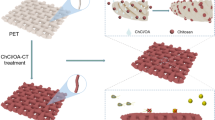Abstract
Deep eutectic solvent, urea-choline chloride (URC), was used to control surface of poly(ethylene terephthalate) (PET) fabric under microwave irradiation with or without sodium hydroxide (NaOH) for hydrophilic-hydrophobic properties. Wicking and contact angle evaluations indicated that the URC-treated PET fabric drastically changed its surface characteristics from highly hydrophobic to highly hydrophilic (or vice versa) by carefully adjusting alkali concentration and microwave irradiation time. For instance, an instant wicking was achieved on URC-treated PET with 1 % NaOH at 60 s of microwave irradiation, whereas highly hydrophobic PET surface with 2600 s wicking time and 135.6 ° contact angle was acquired by adding 5 % NaOH at the same microwave irradiation. Methylene Blue staining and FTIR analyses suggested that a minimal hydrolysis occurred through URC-treatment with NaOH under microwave irradiation and hydrophilicity was mainly achieved by physical disruption of the fiber. The treated fabrics were further analyzed by DSC, TGA, and SEM. Therefore, a rapid control of hydrophilic-hydrophobic surface of PET fabric was achieved with a little side reaction by using environmentally-benign, biodegradable URC deep eutectic solvent.
Similar content being viewed by others
References
C. Sammon, J. Yarwood, and N. Everall, Polym. Degrad. Stabil., 67, 149 (2000).
J. Y. Cho, C. J. Hong, and H. M. Choi, Ind. Eng. Chem. Res., 52, 2309 (2013).
H. Wang, R. Yan, Z. Li, and S. Zhang, Catal. Commun., 11, 763 (2010).
M. Y. Kwon, H. M. Choi, and C. J. Hong, Text. Sci. Eng., 46, 129 (2009).
A. P. Abbott, G. Capper, D. L. Davies, R. K. Rasheed, and V. Tambyrajah, Chem. Commun., 39, 70 (2003).
C. A. Nkuku and R. J. LuSuer, J. Phys. Chem. B, 111, 13271 (2007).
M. Anouti, M. Caillion-Caravanier, Y. Dridi, H. Galiano, and D. Lemordant, J. Phys. Chem. B, 112, 13335 (2008).
A. P. Abbott, D. Boothby, G. Capper, D. L. Davies, and R. K. Rasheed, J. Am. Chem. Soc., 126, 9142 (2004).
A. P. Abbott and K. J. McKenzie, Phys. Chem. Chem. Phys., 8, 4265 (2006).
S. T. Disale, S. R. Kale, S. S. Kahanadal, T. G. Srinivasan, and R. V. Jayaram, Tetrahedron Lett., 53, 2277 (2012).
A. A. Shamsuri and R. Daik, BioResource, 7, 4760 (2013).
S. Wang, W. Chen, E. Wang, Y. Li, X. Feng, and L. Liu, Inorg. Chem. Commun., 13, 972 (2010).
M. Francisco, A. Bruinhorst, and M. C. Kroon, Green Chem., 14, 2153 (2012).
C. C. Gu, X. J. Xu, and T. P. Tu, J. Phys. Chem., 114, 13614 (2010).
J. H. Park, K. W. Oh, and H. M. Choi, Cellulose, 20, 2101 (2013).
D. Katovic, S. Bischof Vukusic, G. S. Flincec, S. Kovacevic, and I. Schwarz, Text. Res. J., 78, 353 (2008).
J. Y. Cho, H. M. Choi, and C. J. Hong, Fiber. Polym., 16, 934 (2015).
J. Chen and K. Isa, J. Mass. Spectrom. Soc. Jpn., 46, 299 (1998).
S. Niu, T. Wakida, S. Ogasawara, H. Fujimatsu, and S. Takkoshi, Text. Res. J., 65, 771 (1995).
Author information
Authors and Affiliations
Corresponding author
Rights and permissions
About this article
Cite this article
Choi, HM., Cho, J.Y. Microwave-mediated rapid tailoring of PET fabric surface by using environmentally-benign, biodegradable Urea-Choline chloride Deep eutectic solvent. Fibers Polym 17, 847–856 (2016). https://doi.org/10.1007/s12221-016-5334-1
Received:
Revised:
Accepted:
Published:
Issue Date:
DOI: https://doi.org/10.1007/s12221-016-5334-1




